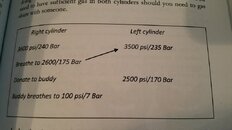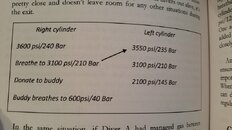Actually the OP has it exactly right. Unfortunately most SM divers don't think it through.
Let's say you have a pair of cave filled 85s with 3600 psi in each tank.
You start the dive on the left tank and breath 1/3rd of it (switching at 2400 psi). This leaves you a 1200 psi differential, which is about 38 cu ft, which weighs about 2.8 pounds, which isn't much of a weight differential. If you find that it is, you might want to work on your configuration a bit.
You continue the dive breathing off the right tank until you reach 2400 psi - which is your turn pressure if you're in a no flow system doing normal rule of thirds gas planning.
(If you're in siphon or leaving more reserve for a slower exit, then turn at what ever pressure you normally would 2300, 2200, 2100, it doesn't matter, 2400 is the critical presses as it's the 'worst case" pressure if you lose all the gas in one tank at max penetration.)
At this point in the dive (turn pressure in both tanks and at max penetration), you've used 1/3rd of the gas in each tank and you have 2/3rd (2400 psi) left in each tank. So if you suddenly lost all the gas in each tank, you've still got twice as much gas as you used for the penetration left in the remaining tank.
You stay on the right tank until you get down to 1200 psi, and then you switch back to the left tank and continue the exit, and you should be out at or before 1200 psi in the left tank.
In practice, most cave fills today seem to be in the 3800-4000 psi range, but I still dive 1200 psi thirds if I;ve diving in small, tight passage, so it adds even more gas reserve for a slower, silty exit.
Over time as you become a more experienced diver you'll become very aware of depth, work load and gas consumption and you'll get very good at estimating remaining gas. You'll find yourself checking the SPG for the first time about 200-300 psi short of your turn pressure, because that's when your sophisticated diving computer (brain) is telling you you're getting close to turn pressure. You'll check again at the switch at turn pressure, and you'll check a third time just before you make the second switch, which is also keyed by being about half way out of the cave/back to the boat or each, etc, where I'll normally switch anyway, above 1200 psi to balance the gas at exit, and to split the excess reserve gas between each tank.
So...two switches, minimal complexity, no excessive gas differential side to side, and a great deal of flexibility in balancing the reserve on the way out by varying the last switch slightly.
To me it's a total no brainer argument, but you'd be surprised how many people disagree with this approach.
The opposing view is to just switch every few hundred PSI to keep both tanks within a few hundred psi of each other. There's nothing wrong with that I suppose, and no one seems to be dying from it. But it adds a number of gas switches and leaves the diver overly involved with gas switching when their attention might be better directed to other aspects of the dive. Worse, then their at depth, they run the risk of being more concerned with balancing the tanks than actually recognizing they are in fact at turn pressure and turning the dive.
I prefer to keep it simple by just needing to remember a single number - the turn pressure for the dive.






